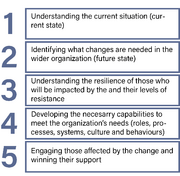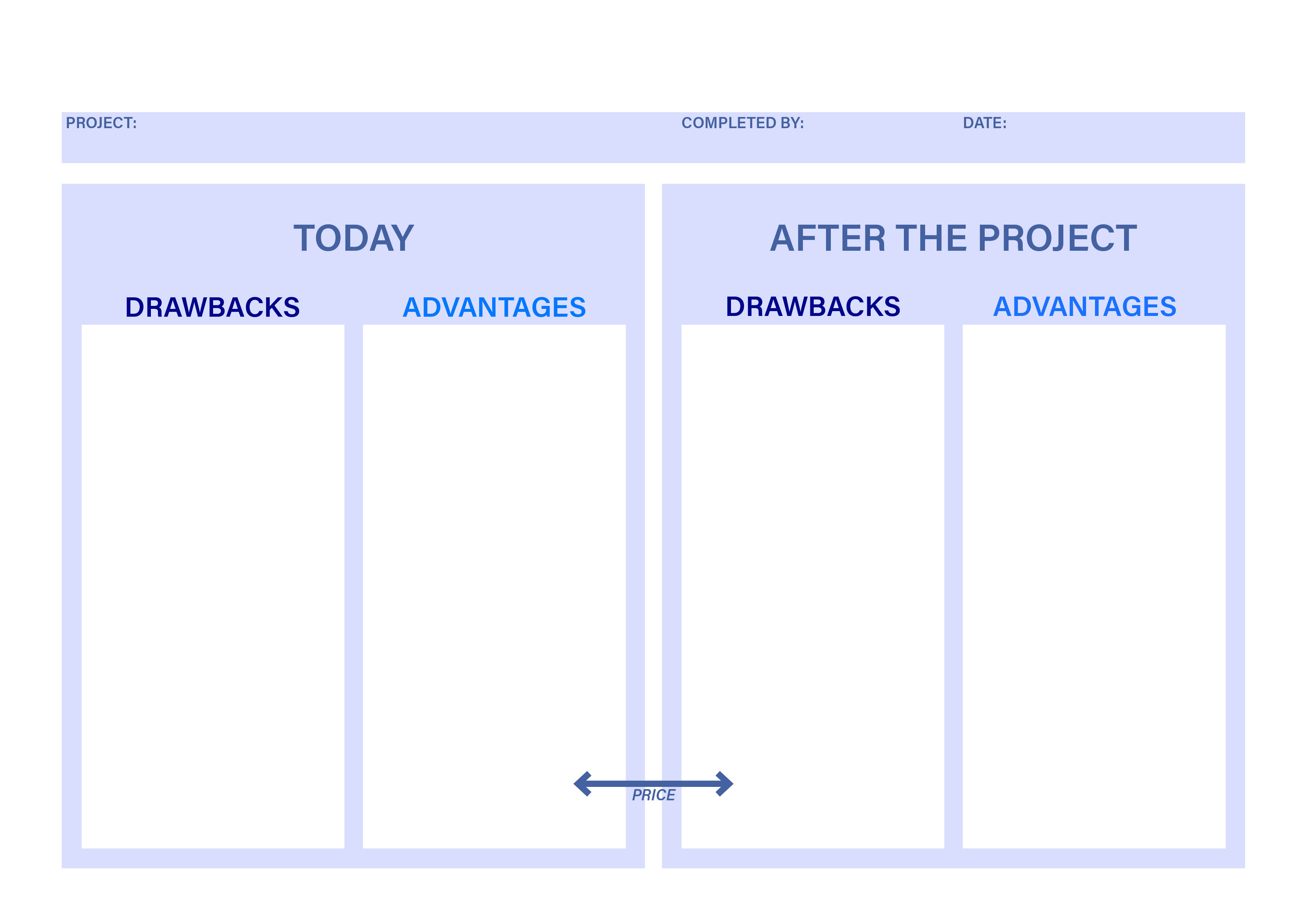Resistance to Change Mapping
| Line 34: | Line 34: | ||
| − | [[Image:Change to restiance mapping figure.jpg | + | [[Image:Change to restiance mapping figure.jpg|frame|Figure 2: Resistance to Change Mapping <ref name="Olsson_et_al"/>|40px|center]] |
Revision as of 21:02, 8 April 2023
Projects related to change are almost inevitable to receive resistance from some of the people who will be affected by the change [1]. Dent and Goldberg [2] argues that people don't resist the change itself but the unknown. To accommodate the resistance, it’s important to shed light on the uncertainties the affected employees might have and the project manager's rationale behind the changes [3]. To enhance the employees’ readiness for change and thereby reduce their resistance project managers must help to make sense of the changing situation [3]. Resistance to Change Mapping is a tool which can help to facilitate communication between the stakeholders with low influence and high interest, and the project managers and owners to involve the people affected by the change [1].
The purpose of this article is to introduce the tool ‘Resistance to Change Mapping’ as a change management tool to assess various stakeholders’ oppositions. The objective is to create a space for stakeholders to address their concerns and give rise to project managers to make initiatives to accommodate the drawbacks and uncertainties related to the change. Thus, reducing the resistance and increasing the likelihood of the project's success [1].
Contents |
The Big idea
Introduction
There are several characteristics of project work according to PRINCE2, including change. Since projects are how a change is introduced [4], change management becomes an essential part of project management. The standard states that the key aspect of change models is to gain support from those who are required to change their ways of working [4]. This involves the five points listed in figure x. The Resistance to Change Mapping tool is especially useful in understanding the resilience of those who will be impacted by the change, thus making it clear to change managers which initiatives they need to implement or communicate more clearly.

The PMI Standard for project management also addresses how every project contains an aspect of change in systems, behaviors, activities, or cultures [5]. The standard introduces five different change models, and all of them describe that resistance to change is almost inevitable, and thus the importance of people understanding why a change is desired [5].
Resistance to change is a natural part of the change process, and different logical reasons exist as to why organizational members may not show their support from the beginning [6]. From a change management perspective, it's important to understand these behaviors and the reasons behind them, and take actions to accommodate the concerns of organizational members and increase their support for the change [3].
Resistance to Change Mapping is a tool that can help to identify the reasons behind the resistance to change and make the cost of the change clear [1].
Resistance to Change Mapping
Resistance to Change Mapping is a tool used to allow stakeholders who have a low influence but a high interest to express their doubts and resistance to a given change, while also clarifying the costs of the change [1]. By utilizing the tool, change managers can optimize their communication with stakeholders by gaining a better understanding of how each individual or group responds to the proposed change [7]. When changes are being implemented, project managers tend to focus on the drawbacks of the current situation and the advantages of the future situation. However, stakeholders with low influence and high interest are more focused on the advantages of the current situation and the drawbacks related to the change [1]. Resistance to Change Mapping is divided into the current situation and the situation after the implementation, with further categorization into the drawbacks and advantages of each. The affected stakeholders and project managers collaborate to outline their thoughts for each section, creating a shared understanding. The project managers then use the output to address the identified drawbacks related to the change and improve communication with stakeholders [1].

Application
It is important to involve the right people when utilizing the tool, as the output is only as good as the team conducting the assessment. If project managers do not have a good understanding of the stakeholders involved, conducting a stakeholder analysis would be beneficial. The tool should be utilized early in the project and revised continuously, as it only provides a snapshot of the stakeholder opinions about the change[7].
Once the team has been identified, they should physically meet with the project manager to conduct the tool. At the beginning of the workshop, the project manager shares the intention of the meeting and the purpose of Resistance to Change Mapping. The framework of the tool should either be printed in a large scale or drawn on a whiteboard to make the expectations of the participants clear. Each member of the workshop writes their thoughts, concerns, doubts, excitements, and other relevant points on post-it notes for a set period of time, and then each individual presents a post-it note one at a time, explaining their thoughts behind it and placing it in the framework.
Before and during the meeting where the tool is being conducted, it is essential to create an open environment where all kinds of feedback are welcome. The project managers should listen without defending their project or neglecting the concerns expressed by the stakeholders [1].
To increase candor and quality of meetings, project managers can adopt different behaviors and actions, such as asking for permission upfront in meetings to lead effectively and telling the team what they have permission to do, even though it might seem redundant [8].
It is also important that the team feels safe in order to express exactly what they are thinking. The project manager could ask team members to pay attention to the person talking, take their time to complete their thoughts, ask follow-up questions, and other statements or questions that might increase psychological safety [8].
- Future work: Example
Limitations
Every tool has its limitations, including Resistance to Change Mapping. Some of the limitations include, as mentioned earlier, that the output is only as good as the team utilizing it. If stakeholders with low influence but whose tasks are being affected by the change do not become involved and thus become resistant to the unknown, the change is less likely to succeed [1]). Additionally, the tool does not provide any specific actions for project managers to implement a communication strategy. It only helps to gain a better understanding of the unspoken uncertainties and misgivings the stakeholders might have. Resistance to Change Mapping only provides a snapshot of the team’s thoughts related to the change, thus, it needs to be conducted several times throughout the project period.
Annotated bibliography
Olsson, J.R., Ahrengot, N. and Attrup, M.L. (2018) Power I Projekter og Portfølje. Viborg: Djøf Forlag This book provides a comprehensive overview of power dynamics in project and portfolio management. The authors present a theoretical framework for understanding power, its sources, and its effects on project outcomes. They also provide practical guidance on how to manage power in different project contexts, such as change and communication.
Axtell, P. (2019) Make your meetings a safe space for honest conversation, Harvard Business Review This article provides valuable insights and practical advice for leaders who want to improve the quality of communication and decision-making in their teams. Having a focus on how to give permission and creating safety.
References
- ↑ 1.0 1.1 1.2 1.3 1.4 1.5 1.6 1.7 1.8 1.9 "Olsson, J.R., Ahrengot, N. and Attrup, M.L. (2018) Power I Projekter og Portfølje. Viborg: Djøf Forlag."
- ↑ "Dent, E.B. and Goldberg, S.G. (1999) “Challenging ‘resistance to change,’” The Journal of Applied Behavioral Science, 35(1), pp. 25–41. Available at: https://doi.org/10.1177/0021886399351003."
- ↑ 3.0 3.1 3.2 "Kreye, M.E. (2020) “Reading material 42543 - Management of Change.” Kongens Lyngby: Technical University of Denmark."
- ↑ 4.0 4.1 4.2 "Axelos 2017, Managing Successful Projects with PRINCE2 2017 Edition, The Stationery Office Ltd, London. Available from: ProQuest Ebook Central. [8 April 2023]."
- ↑ 5.0 5.1 "Project Management Institute, Inc. (PMI). (2021). A Guide to the Project Management Body of Knowledge (PMBOK ® Guide) – 7th Edition and The Standard for Project Management - 4.2.4.4 Virginia Satir Change Model. Project Management Institute, Inc. (PMI). Retrieved from https://app.knovel.com/hotlink/pdf/id:kt012LZKR6/guide-project-management/virginia-satir-change"
- ↑ "Conner, D.R. (1992) Managing at the speed of change: How to prosper in an uncertain world."
- ↑ 7.0 7.1 "Olsson, J.R. (no date) Det dobbelte bogholderi, airborn leadership. Available at: https://airbornleadership.com/tool/det-dobbelte-bogholderi/ (Accessed: February 11, 2023)."
- ↑ 8.0 8.1 "Axtell, P. (2019) Make your meetings a safe space for honest conversation, Harvard Business Review. Available at: https://hbr.org/2019/04/make-your-meetings-a-safe-space-for-honest-conversation (Accessed: April 7, 2023)."